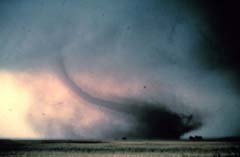|
NOAA Magazine || NOAA Home Page WEATHER EVENT SIMULATOR HELPS FORECASTERS TRAIN FOR THE WORST
The Weather Event Simulator, similar in concept to flight simulators used for pilot training, is now installed in NOAA's National Weather Service forecast offices around the country. The new program is an effort to keep forecasters ready to deliver accurate, life-saving forecasts. "Simulations are an effective training tool," said retired General Jack Kelly, director of NOAA's National Weather Service. "Studies from the Departments of Defense and Transportation, and the private sector, have shown 25 hours of quality simulation training can achieve about two years of experience." Following a deadly tornado outbreak in downtown Fort Worth, Texas, on March 28, 2000, NOAA's National Weather Service recognized the need for a weather simulator, and re-prioritized existing resources to develop one, Kelly said. The agency's Warning and Decision Training Branch worked with the Cooperative Program for Operational Meteorology, Education and Training to finish creating the simulator. The concept of the Weather Event Simulator to train forecasters was the brainchild of Mike Foster and David Andra, who at the time were meteorologists at the forecast office in Norman, Okla. Foster was on duty during the Fort Worth tornado event. His long experience as a forecaster, he said, prompted him to issue a tornado warning, even though some of the classic tornado signs were not visible. That move, which was credited with saving lives, earned him this year's American Meteorological Society Award for Exceptional Specific Prediction. "The airlines all use simulators to train their pilots to handle a variety of emergency situations and equipment malfunctions," Andra said. "Meteorologists need similar preparation to forecast dangerous weather conditions with top-notch skill." All 121 weather forecast offices and 13 river forecast centers have the Weather Event Simulator hardware and software. Training in hardware configuration, software and case study installation, local data archiving and field office training strategies is underway. "Whether they've been on the job for two weeks or 20 years, the Weather Event Simulator will allow every forecaster to work the ‘big event'," Foster said. NOAA's National Weather Service is the primary source of weather data, forecasts and warnings for the United States and its territories. NOAA's National Weather Service operates the most advanced weather and flood warning and forecast system in the world, helping to protect lives and property and enhance the national economy. Relevant Web Sites
|
